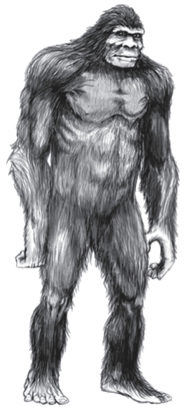 Fifty years ago construction worker Jerry Crew found his tracks; today biologists pursue him by high-tech means. We are talking about Bigfoot, America’s legendary creature.
Fifty years ago construction worker Jerry Crew found his tracks; today biologists pursue him by high-tech means. We are talking about Bigfoot, America’s legendary creature.
People who have supposedly seen Bigfoot in various locales of the USA describe the creature as two to three meters tall, hairy and with ape-like facial features. Also notable are the gait and gigantic footprints left behind. This last feature prompted journalist Andrew Genzoli to coin the term Bigfoot. Nowadays, many prefer the term Sasquatch, a name of North American native derivation, originally meaning “Lord of the Forest.” Is it possible that such a creature can lead its life these days, hidden away from science?
Enormous and Black
Alton Higgins belongs to a growing group of persons who have encountered Bigfoot. And he isn’t just anybody: Alton Higgins is a biologist and teaches at Mid-America Christian University in Oklahoma City. “Theoretically, I can’t claim to have seen a bigfoot, in that the existence of this creature has not been proven.” Nevertheless, Higgins claims to have seen an animal in 2002 in Oklahoma that is not contained in any guide to mammals. “I saw a gigantic, black animal, which ran away from me with great speed on two legs,” says the 57 year-old. He observed the animal from a distance of about 40 m under perfect viewing conditions.
Higgins has pursued Bigfoot for 10 years. In 1998 he found a 40 cm long footprint in Washington State. “I couldn’t assign it to any known animal.” Today he is a member of the Texas Bigfoot Research Conservancy, a group of scientists and outdoor enthusiasts who operate under the banner of the documentation and protection of Bigfoot. “We have installed roughly 30 camera traps in the wilderness of Arkansas, Louisiana, Texas and Oklahoma.” To date, no Bigfoot has crossed the infrared beam to trigger one of the traps.
Search by a Swiss Researcher
For 50 years people like Alton Higgins have searched for proof of the existence of Bigfoot. At the end of the fifties construction worker Jerry Crew found gigantic footprints in the vicinity of the California town of Willow Creek and cast them in plaster of Paris. The photo of him posing with the cast was publicized around the world. It was the starting bell for the search for Bigfoot. Always at the forefront of these efforts was the Swiss René Dahinden. He immigrated from Luzern to Canada in 1953 and spent his life searching for the creature.
From colonial days through to the present day, people supposedly encountered the big-footed creatures time and again; even the native Indians reported the sasquatch. But what, in fact, is a sasquatch? For Jeff Meldrum, an anthropologist at Idaho State University, the answer is Gigantopithecus, a gigantic ape that lived in prehistoric Asia. “Giganto” is considered to have immigrated to North America by way of the Bering land bridge. That sounds reasonable to Alton Higgins: “Gigantopithecus is a good candidate, but what that theory demonstrates above all is that the sasquatch is not a biological absurdity. Such an animal thrived at one time, and there are no biological or ecological reasons why it couldn’t exist today.”
Believers and Fakers
Higgins and Meldrum are among the few scientific advocates of Bigfoot. In 2002 they received prominent support from the well-known chimpanzee researcher Jane Goodall. She revealed in a radio interview that she believes in the existence of Bigfoot, stating, “I am sure that it exists.” Discussions with American Indians had convinced her.
However, many of Goodall’s colleagues think otherwise. David Daegling, an anthropologist at the University of Florida, seriously doubts the existence of Bigfoot. “How can such a large animal remain undiscovered, when it has been looked for for decades? To date, nobody has found bones or other remains of Bigfoot. But that should have happened.” For Daegling, Bigfoot is not a biological phenomenon, but a sociological one: “It is basically an interaction of, on the one hand, Bigfoot believers, for whom it has profound significance – for example as a symbol of raw nature – such that they can’t dismiss it as a myth, and, on the other hand, of fakers, who lay down Bigfoot prints and fake other evidence.” Thereby arise mistaken and imaginary details.
Why no Remains?
It is clear to Alton Higgins that his sighting was not imaginary. “It was no bear and it wasn’t a man,” said Higgins. “Many people in that area have similar reports.” Higgins has explanations why no remains have been found in 50 years. “The sasquatch is rare, it has a long life span, and it decays rapidly after death.” The latter argument holds for other animals as well. “In the USA there are millions of white-tailed deer, but you hardly ever find their bones.”
It is questionable whether Bigfoot will one day leave the realm of legend for that of biological reality. Conversely, it is a fact that new species are constantly being discovered. Recently, the World Wildlife Fund published a report about discoveries in the Mekong Delta area. Over 1,000 new species of plants and animals were found there, including a new species of deer. Even among primates, major discoveries are rather recent: The first scientific description of the Mountain Gorilla was provided only in 1903. Prior to its discovery it was considered to be a myth, a product of the imagination of adventurers.
This article was originally published on 3 May 2009 in the Swiss newspaper Zentralschweiz am Sonntag (Central Switzerland on Sunday).
REFERENCES
Daegling, David. (2004). Bigfoot Exposed: An Anthropologist Examines America’s Enduring Legend. 276 pp. AltaMira Press. Walnut Creek, California.
Meldrum, Jeff. (2006). Sasquatch: Legends Meets Science. 304 pp. Forge Books. New York, NY.
The Texas Bigfoot Research Conservancy, www.woodape.org.
